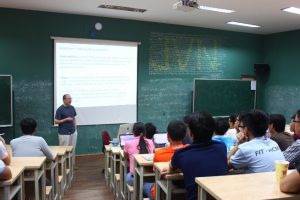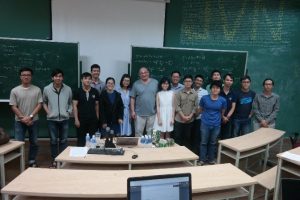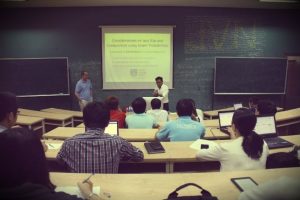 Course overview
Course overview
Students build knowledge on the basic concepts and methods of decision theory. They further develop practical skills for applying theoretical constructs to a variety of interesting and important problems. At the same time, students learn how to combine different analysis techniques for solving practical problems and defend their solutions to the lecturer.
Participants in piloting
The course is part of the Quantitative Computational Finance graduate program at John von Neumann Institute. This course is also offered in some Applied Mathematics graduate programs at the University of Economics and Law (VNUHCM) and the University of Natural Sciences (VNUHCM). The following groups of students were engaged:
- 22 students in semester 2 of academic year 2018 – 2019.
- 17 students in the semester 2 of the academic year 2019 – 2020.
The lecturer of the course is Dr. Brett Houlding (TCD) and Dr. Man Ngo (JVN). Trinity College Dublin (TCD) is the partner of JVN in the VIDAI project funded by Irish Aid.
Timeframe
Spring 2019
Spring 2020
Use of ALIEN services and tools
Students were exposed to active learning through weekly lectures and tutorials. Practical activities took place in the ALIEN problem-based learning lab. The course included a series of activities for building knowledge and applying newly developed skills in decision making in finance or business situations. This work does not only require technical skills, such as data model design and analysis, but also business skills to define and identify appropriate analysis techniques. Diverse learning activities and teaching methodologies were used to best address the objectives of each learning session.

Students implemented the following steps:
- Students studied analysis techniques and finished the exercises in different contexts given by the lecturer.
- Students selected a topic in a pre-defined list and prepared a data story through which they illustrated the related concepts to the lecturer and their classmates.
- Students researched different data analysis models and data sources applicable in their scenario.
- Students reviewed lessons with interactive games using Kahoot®. Students created the games themselves under teacher guidance. After each game, the lecturer posed questions on the wrong or unclear answers, encouraging students to discover more on the missed points.
- Students played scenario games in which they provided input related to the practical application of knowledge and techniques in decision making.
- Students used R, Python, and Google® Class to build and share their results with their classmates and lecturer.

In the context of tutorials, students further implemented the following activities:
- Students worked in groups on the analysis of the scenario that they selected and prepared a presentation summarizing their findings for the benefit of their classmates.
- Students summarized their results in a shared document that they collectively edited.
- Students assumed roles of professionals in a data science department. They discussed plans for applying their knowledge and skills in the context set by the lecturer.
- Students raised concerns or interests during the course and engaged in discussions with their classmates in the final session. The lecturer helped students align their points with the framework of the course for developing more effective understanding of concepts and enabling student to apply new knowledge in practice.


